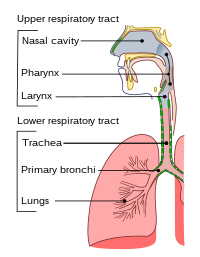
Photo from wikipedia
Upper respiratory illnesses due to viruses are the most common reason for pediatric emergency department (ED) visits in the United States. We explored the clinical characteristics, hospitalization risk, and symptom… Click to show full abstract
Upper respiratory illnesses due to viruses are the most common reason for pediatric emergency department (ED) visits in the United States. We explored the clinical characteristics, hospitalization risk, and symptom duration of children in an ED setting by respiratory pathogen including coinfections. A retrospective analysis was conducted from a randomized controlled trial evaluating a rapid molecular pathogen panel among 931 children 1 month to 18 years of age with acute respiratory illness. We assessed hospitalization risk by pathogen using multivariable Poisson regression with robust variance. Symptom duration was assessed using multivariable Cox proportional hazards models. Among 931 children, 702 (75%) were aged 0–5 years and 797 (85%) tested positive for a respiratory pathogen. Children with respiratory syncytial virus (RSV), human metapneumovirus (hMPV), and human rhinovirus/enterovirus (HRV/EV) had higher hospitalization risk compared with influenza (adjusted risk ratio [aRR]: 2.95, 95% confidence interval [CI]: 1.17–7.45; 3.56, 95% CI: 1.05–12.02; aRR: 2.58, 95% CI: 1.05–6.35, respectively). Children with RSV, parainfluenza and atypical bacterial pathogens had longer illness duration compared with influenza (adjusted hazards ratio [aHR]: 2.16 95% CI: 1.41–3.29; aHR: 1.67, 95% CI:1.06–2.64; aHR: 2.60 95% CI: 1.30–5.19, respectively). Children with RSV, hMPV, and atypical bacterial pathogens had higher illness severity and duration compared with other respiratory pathogens. Coinfection was not associated with increased illness severity.
Journal Title: Journal of Medical Virology
Year Published: 2022
Link to full text (if available)
Share on Social Media: Sign Up to like & get
recommendations!